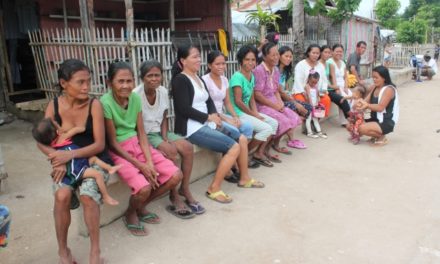
In the background, women healthcare workers prepare COVID-19 vaccines. Women constitute most workers in the health and social work sector as well as other sectors that have borne the brunt of the pandemic and the lockdown-induced economic crisis. Caloocan City. 2021 June 17. Photo by the Asian Development Bank.
As the Philippines entered the second year of the pandemic, the Duterte administration geared up towards pursuing economic recovery. Despite peddling optimistic projections for the economy and vague platitudes about “real change for future generations,” the political and economic scars from the past two years cannot be concealed. Millions of people from the most vulnerable sectors and communities have been left behind since the onset of the pandemic, and they remain left out in the recovery plans.
Across these sectors and communities, the most vulnerable—but also the ones who make the most significant contributions towards economic recovery—are women. This article will assess the impacts of the government’s pandemic response as well as the implications of some key elements of its economic recovery plan on women. One thing that is clear from the assessment is that the government’s economic recovery plan is inherently opposed to women’s interests and welfare. Thus, to conclude, the article identifies key points of a more just and inclusive economic recovery.
Women’s pre-pandemic economic disposition
To understand precisely how the government’s policy responses to the COVID-19 pandemic as well as its neoliberal economic recovery plan will affect women, it is first important to have an appreciation of their economic situation prior to the pandemic.
The most recent sex-disaggregated statistics on labor and employment consolidated by the Philippine Statistics Authority (PSA) dates back to 2017. Despite it being released two years before the last pre-pandemic year (2019), the 2017 report (which also includes data from previous years) remains an important source that could reveal trends and developments in women’s economic situation prior to the pandemic.
The 2017 data shows that of all employed Filipino women, a significant portion continued to rely on low quality jobs that were highly vulnerable to disruptive global events like the COVID-19 pandemic. More than a third of employed women were engaged in part-time work, while 51 percent of them worked in the informal economy. On the other hand, 37.2 percent of total employed men work in the informal economy. This means that women tend to find jobs in the informal sector more often than men do.
One of the most glaring structural barriers that prevents women from accessing decently paid and secure work is the traditional assignment of unpaid care work to women. Thus, most of them are driven into taking on flexible jobs that would allow them to attend to care responsibilities. However, with the government’s liberal definition of “employment” that includes informal and irregular work, official data obscures the quality of jobs being created.
Moving on to the major industry groups, data shows that the majority of women in the service sector are employed in wholesale and retail trade (41.3 percent), public administration and defense (9.6 percent), accommodation and food service (8 percent), and education (7.6 percent).
On labor migration, the Philippine Statistics Authority (PSA) was able to release more recent sex-disaggregated data in 2019. It shows that more women also relied on overseas work as compared to men. Female Overseas Filipino Workers (OFWs) constitute the majority of OFW deployment at 56 percent, whereas male migrant workers made up 44 percent. Furthermore, female OFWs mostly took on elementary occupations (including domestic work), which remained the largest occupation group that made up 62.5 percent of all migrant women in 2019. Service and sales composed the second largest occupation group which accounted for 17.7 percent of female OFWs.
What accounts for the increasing reliance of female OFWs on low-paying, insecure domestic labor that is often prone to workplace abuse is the emergence of so-called global care chains. Linking women globally through the transnational exchange of domestic work, these chains are underpinned by the growing inequality between women in the global north and women in the global south on the one hand, and on the other,the persistence of patriarchal values that devalue care work while also ascribing them to women. Indeed, while more women in wealthy countries are entering the workforce, their households are also seeing an increasing demand for paid domestic labor given that there is no corresponding increase in state support for childcare, nor is there a fair redistribution of caring responsibilities. In global south countries, the supply of domestic labor has been stimulated by a scarcity in well-paying jobs which, in many cases, have forced women to find jobs abroad and to become increasingly reliant on remittances.
Another sector dominated by women that was also made vulnerable by the pandemic is health and social work. On average, women have constituted 67.4 percent of the sector from 2013 to 2017, whereas men made up 32.3 percent of the sector during the same period. However, women tend to have lower wages compared to men in the health sector, as seen in the table below. This implies that while more women are getting employed in the sector, their distinct contributions are considered as mere “support occupations” within a highly hierarchized workforce and are thus undervalued.
Average nominal wages in the human health and social work sector by sex, 2013-2017 (in Philippine Peso)
| Indicator | 2013 | 2014 | 2015 | 2016 | 2017 |
| Nominal wages of health and social service workers (both sexes) | 523.55 | 557.05 | 558.37 | 597.05 | 611.78 |
| Women | 514.80 | 539.01 | 554.67 | 591.77 | 599.07 |
| Men | 541.58 | 592.12 | 566.08 | 608.57 | 636.66 |
Source: Philippine Statistics Authority
Health and economic crises worsen gender inequality
Given the economic vulnerability of the majority of women even before the pandemic, the COVID-19 pandemic and the government’s lackluster response have further entrenched pre-existing inequalities.
Many of the contact-intensive sectors where women are mostly employed—including tourism, hospitality, sales, and domestic work—were among the hardest hit by the pandemic and the extreme lockdowns imposed by the government. This is reflected in the larger increase in female unemployment than male unemployment.
In the aftermath of the first surge of infections which occurred from August to September 2020, the unemployment rate among women rose to 8.9 percent, while that among men was recorded at 8.7 percent. During the height of the Delta-driven second wave in April 2021, unemployment among women peaked at 9.1 percent, while 8.5 percent of men in the labor force were reported to be unemployed. Finally, during the third wave that started in August 2021, 8.3 of women were unemployed as against 7.9 percent unemployed men.
Apart from unemployment, another crucial indicator that would allow us to understand women’s economic disposition is the labor force participation rate (LFPR). Over the past two years since the pandemic began, female LFPR has also been declining and has not gone back to pre-pandemic levels. What may account for women’s decreasing LFPR is the formidable expectation on women to fulfill their responsibility as caregivers. This may be forcing some of them to quit their jobs so they can better attend to household chores, which have considerably increased with work from home arrangements and online school.
Abroad, thousands of female migrant workers also lost their jobs. The most recent sex-disaggregated data on repatriated OFWs as of October 2020 shows that more than 200,000 female OFWs have returned to the country. Following the period of data collection, more women OFWs were expected to have been displaced given that they were employed in the sectors most affected by the pandemic in terms of economic output.
Women who were able to keep their jobs amid the pandemic did not necessarily have it better. In the health and social work sector where women make up the majority and yet earn less than their male counterparts (see table above), women were made more vulnerable to greater amounts of stress, burnout, anxiety, and exposure to the virus. This is mainly due to the lack of protective equipment, poor distribution of the burden of work due to limited health facilities and manpower, low wages, and insufficient benefits.
The deterioration of the healthcare sector in the hands of an incompetent government has significantly contributed to further undermining women’s sexual and reproductive health and rights (SRHR). The COVID-19 pandemic has increased the barriers to family planning and maternal and newborn health services by overwhelming the already understaffed and overworked healthcare workforce and pushing other much-needed health services to the peripheries.
Abandoning women in the name of fiscal conservatism
The problems of job loss, decline in incomes, and limitation of access to sexual and reproductive health services were made worse by the lack of financial aid and social protection from the government and its de-prioritization of social services.
When it drafted the budget for 2021 and 2022, the government no longer made allocations for emergency subsidies for poor households. Cash transfers were limited to the existing beneficiaries of the conditional cash transfer program. But even here, transfers were not increased to sufficiently recoup the massive losses from 2020 and 2021. Wage subsidies and other forms of assistance for displaced workers, repatriated OFWs, drivers and owners of public utility vehicles, and micro, small, and medium enterprises (MSMEs) were also significantly reduced.
The negative impacts of the government’s fiscal conservatism have disproportionately affected women. As seen in the previous section, the majority of women were already economically vulnerable prior to the pandemic. Thus, when the pandemic dealt its hardest blow on the economic sectors that most women were employed in, made them more susceptible to job and income loss, and compelled many of them to leave their jobs to fulfill their caregiving responsibilities, more women also became even more dependent on state subsidies than they were before the pandemic.
The reason behind the cuts in social amelioration was the government’s prediction—both during the end of 2020 and 2021—that the economy would recover and that jobs would return the following year. Of course, this did not happen. As everyone but the government had realized from the first year of the pandemic, it was impossible for the economy to fully recover without first strengthening the capacity of the healthcare system to contain the pandemic.
What the Duterte administration did, however, was the exact opposite. For two years, it has underfunded aspects of the healthcare system that are critical to pandemic response, including personal protective equipment, test kits, vaccines, various key facilities, compensation for various health workers including contact tracers and those deployed to unserved and underserved areas. On top of budget cuts, there had been numerous delays in the provision of healthcare workers’ hazard pay, special risk allowance (SRA), and meal, transportation, and accommodation allowance that prompted thousands of them to stage massive protests in 2021.
Considering the feminization of the health sector and the existing gender pay gap, the continuing neglect of the health sector creates a heavier burden for women. Furthermore, slashing the budget for healthcare workers deployed in rural areas means less attention and resources for maternal care for rural women. This would have serious implications in numerous remote areas with only one healthcare worker attending to an entire community’s needs. In such cases, the healthcare worker’s attention is usually diverted towards vaccination. Pregnant women only get medical attention when they already need to give birth, and pre-natal and post-natal care become a privilege.
Business-as-usual policies, no genuine recovery for majority of women
The same neoliberal economic framework that has placed women in highly precarious economic dispositions way before the pandemic and exploited their vulnerabilities for profit is the same path being pursued by the government towards economic recovery. Apart from budget priorities, the government’s economic recovery plan can also be deduced from some of the key economic legislations it passed amid the pandemic.
There are several policies that seek to further open the economy to foreign trade and investments. One of these is the Regional Comprehensive Economic Partnership (RCEP), a free trade and investment agreement being forged between ASEAN countries on the one hand, and China, Japan, South Korea, Australia, and New Zealand on the other. One of the key provisions of RCEP is the reduction of tariffs on a range of products. This could lead to tariff revenue losses amounting to $58 million or P2.9 billion. The reduction of government revenue would result in cuts in public expenditure as well, which could have the indirect effect of reducing spending for social services that women rely on more heavily. RCEP will also introduce more stringent intellectual property laws that will provide pharmaceutical companies with unrestrained privileges and ownership over medicine, thereby decreasing access to affordable medication for many people including those specifically needed by women.
Two other key neoliberal policies pushed by the government in the name of economic recovery are the Amendment to the Retail Trade Liberalization Act and Amendment to the Foreign Investment Act (FIA). Essentially, the two sets of amendments seek to further liberalize the small and medium business industry to facilitate the entry of foreign investors and businesses. These would have the effect of creating unfair competition for many small and medium enterprises and possibly driving them out of business.
The governor of the Central Bank of the Philippines (BSP) Benjamin Diokno estimates that Filipino women entrepreneurs dominate the country’s MSME landscape. Furthermore, over the previous years, women on average have comprised the majority of employed persons in industries where most MSMEs have been operating. Some of these industries include wholesale and retail trade, accommodation and food service activities, and financial and insurance activities. Thus, it is safe to assume that a significant number of women work in MSMEs. The Amended Retail Trade Liberalization and FIA therefore also pose an indirect threat to women’s livelihood and incomes.
In terms of debt, the government is also expected to borrow more in 2022. The Department of Budget Management (DBM) estimates that the national government’s fiscal deficit in 2022 will be 1.665 trillion pesos, equivalent to 7.5 percent of GDP. The Duterte administration has already increased national government debt from almost Php 6 trillion in 2016 to Php 11.7 trillion in 2021. Women bear the brunt of massive borrowings and huge reliance on debt. Often, borrowing money from international financial institutions (IFIs) comes with the condition of implementing structural adjustment policies (SAPs) including greater degrees of liberalization, austerity, deregulation, and privatization. In terms of repayment, debt servicing in the Philippines has also been eating up a huge chunk of the national budget for decades by virtue of the Automatic Debt Appropriations Act. Together, the imposition of SAPs by IFIs and the government’s onerous debt servicing policy threaten publicly funded social services and disproportionately harm women whose care-giving responsibilities make them more reliant on these services.
Feminist vision for economic recovery
Indeed, there can be no genuine and meaningful recovery for women under an economic framework that is inherently patriarchal as it profits and benefits from the exploitation of women, puts value in productive work while discriminating against reproductive work, and de-prioritizes social services and social protection measures in the name of austerity and in many cases to utilize public funds for personal and political gain. Rather, what is needed is economic and social justice that puts people’s interests and welfare over corporate profits. These are important preconditions for gender justice that must be pursued as a crucial aspect of economic recovery.
To this end, a thorough program of national industrialization is needed in order to sustainably increase the availability of decent work with regular incomes. This would also lessen our dependence on global markets and foreign investors. To this end, unjust trade and investment agreements must also be put to an end. These deals often serve as gateways for foreign businesses that usually pay women with poverty wages (even lower than their male counterparts). Free trade and investment agreements also facilitate the entry of highly subsidized foreign products, leading to the decline of manufacturing as well as small-scale and subsistence farming that many women rely on. These deals also provide hard and costly measures to protect corporate interests, while peoples’ rights are left to soft law. In relation to this, more stringent measures to rein in corporate power and stronger regulations to protect the rights of women across different sectors and peoples must also be put in place.
But while it is important to set up the institutions needed for creating more robust and dynamic productive industries, there is also a need to make labor regulatory frameworks and social security more inclusive to informal workers and to remove barriers to the formalization of jobs in the informal sector, where majority of women in the labor force are employed.
A just taxation system that imposes higher taxes on corporations and the superrich is also another precondition for gender justice. This would have the effect of shifting tax burdens away from the poor, increasing tax revenues, and decreasing our reliance on debt. With more revenues and less imposition of structural adjustment programs, more funds could be allocated for social services. In turn, this would compensate for the reproductive and care work mostly done by women.
These are just some of the key economic policy directions that are crucial for a just and inclusive recovery—not just from the pandemic-induced economic recession but also from decades of poverty and inequality spawned by the government’s unwavering adherence to neoliberal policies. However, we cannot expect the present government beholden to corporate interests to implement this much-needed restructuring. Instead, the responsibility of collectively pushing these aspirations forward falls in the hands of civil society. We owe this much to the women in our communities and families whose reproductive and productive labor forms the backbone of our economy.







